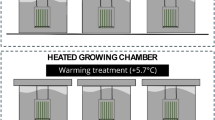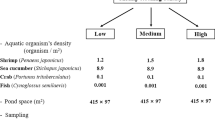Abstract
Limitation of bacterioplankton production by nutrients and temperature was investigated in eight temperate lakes in summer. Six of the lakes were resampled in autumn. The lakes differ in nutrient content, water color, and concentration of dissolved organic carbon. Nutrients (phosphorus, nitrogen, and organic carbon) were added alone and in all possible combinations to filtered lake water inoculated with bacteria from the lake. After incubation for 36–40 h at in situ temperatures (ranging from 7 to 20°C), the response in bacterioplankton production was determined. The effect of increased temperature on bacterioplankton growth was also tested. Bacterioplankton production was often limited by phosphorus alone, organic carbon alone, or the two in combination. Phosphorus limitation of bacterioplankton production was more common in the summer, whereas limitation by organic carbon was more frequently observed in the autumn. There was a close balance between limitation by phosphorus and organic carbon in the epilimnion in the summer. In the hypolimnion in the summer, bacterioplankton growth was primarily phosphorus-limited. The effect of phosphorus additions decreased with increasing phosphorus concentrations in the lakes. However, there were no correlations between the effect of added organic carbon and water color, dissolved organic carbon concentration, or phosphorus concentration. When temperature was low (in the hypolimnion in the summer, and throughout the water column in the autumn) temperature also limited bacterioplankton production. Thus, temperature and inorganic nutrients or organic compounds can limit bacterioplankton growth both alone and simultaneously. However, at low temperatures, temperature is the most important factor influencing bacterioplankton growth.


Similar content being viewed by others
References
RT Bell (1993) Estimating production of heterotrophic bacterioplankton via incorporation of tritiated thymidine PF Kemp BF Sherry JJ Cole (Eds) Handbook of Methods in Aquatic Microbial Ecology Lewis Boca Raton, FL 495–503
RT Bell (1990) ArticleTitleAn explanation for the variability in the conversion factor deriving bacterial cell production from incorporation of [3H] thymidine Limnol Oceanogr 35 910–915
K Bendschneider RJ Robinson (1952) ArticleTitleA new spectrophotometric determination of nitrite in sea water J Mar Res 11 87–96
P Blomqvist RT Bell H Olofssor U Stensdotter K Vrede (1995) ArticleTitlePlankton and water chemistry in Lake Njupfatet before and after liming Can J Fish Aquat Sci 52 551–565
H Box WG Hunter JS Hunter (1978) Statistics for Experimenters John Wiley & Sons New York
G Bratbak TF Thingstad (1985) ArticleTitlePhytoplankton–bacteria interactions: an apparent paradox? Analysis of a model system with both competition and commensalism Mar Ecol Prog Ser 25 23–30
DA Caron E Lin Lim RW Sanders MR Dennet U-G Berninger (2000) ArticleTitleResponses of bacterioplankton and phytoplankton to organic carbon and inorganic nutrient additions in contrasting oceanic ecosystems Aquat Microb Ecol 22 175–184
TH Chrzanowski RW Sterner JJ Elser (1995) ArticleTitleNutrient enrichment and nutrient regeneration stimulate bacterioplankton growth Microb Ecol 29 221–230 Occurrence Handle10.1007/BF00164886
WJ Conover (1980) Practical Nonparametric Statistics EditionNumber2 John Wiley & Sons New York
JB Cotner JW Ammerman ER Peele E Bentzer (1997) ArticleTitlePhosphorus-limited bacterioplankton growth in the Sargasso Sea Aquat Microb Ecol 13 141–149
MT Cottrell DL Kirchman (2000) ArticleTitleNatural assemblages of marine proteobacteria and members of the Cytophaga–Flavobacter cluster consuming low- and high-molecular-weight dissolved organic matter Appl Environ Microbiol 66 1692–1697 Occurrence Handle10.1128/AEM.66.4.1692-1697.2000 Occurrence Handle10742262
MF Coveney RG Wetzel (1995) ArticleTitleBiomass, production, and specific growth rate of bacterioplankton and coupling to phytoplankton in an oligotrophic lake Limnol Oceanogr 40 1187–1200
DJ Currie (1990) ArticleTitleLarge-scale variability and interactions among phytoplankton, bacterioplankton, and phosphorus Limnol Oceanogr 35 1437–1455
PA Giorgio Particledel G Scarborough (1995) ArticleTitleIncrease of the proportion of metabolically active bacteria along gradients of enrichment in freshwater and marine plankton: implications for estimates of bacterial growth and production J Plankton Res 17 1905–1924
JJ Elser BL Stable PR Hassett (1995) ArticleTitleNutrient limitation of bacterial growth and rates of bacterivory in lakes and oceans: a comparative study Aquat Microb Ecol 9 105–110
KM Fagerbakke M Heldal S Norland (1996) ArticleTitleContent of carbon, nitrogen, oxygen, sulphur and phosphorus in native aquatic and cultured bacteria Aquat Microb Ecol 10 15–27
M Felip ML Pace JJ Cole (1996) ArticleTitleRegulation of planktonic bacterial growth rates: the effects of temperature and resources Microb Ecol 31 15–28 Occurrence Handle10.1007/BF00175072
BM Fuchs MV Zubkoy K Saham PH Burkill R Amann (2000) ArticleTitleChanges in community composition during dilution cultures of maine bacterioplankton as assessed by flow cytometric and molecular biological techniques Environ Microbiol 2 191–201 Occurrence Handle10.1046/j.1462-2920.2000.00092.x Occurrence Handle11220305
W Goedkoop L Sonesten (1995) ArticleTitleLaborationsmanual för kemiska analyser av inlandsvatten och sediment [in Swedish] Scripta Limnologica Upsaliensia 1995 B 12
JP Grover TH Chrzanowski (2000) ArticleTitleSeasonal patterns of substrate utilization by bacterioplankton: case studies in four temperate lakes of different latitudes Aquat Microb Ecol 23 41–54
TB Gurung J Urabe (1999) ArticleTitleTemporal and vertical differences in factors limiting growth rate of heterotrophic bacterial in Lake Biwa Microb Ecol 38 IssueID2 136–145 Occurrence Handle10.1007/s002489900167 Occurrence Handle10441706
A-L Haglund E Törnblom B Boström L Tranvik (2002) ArticleTitleLarge differences in the fraction of active bacteria in plankton, sediments, and biofilms Microb Ecol 43 232–241 Occurrence Handle10.1007/s00248-002-2005-0 Occurrence Handle12023730
DO Hessen T Andersen A Lyche (1990) ArticleTitleCarbon metabolism in a humic lake: pool sizes and cycling through zooplankton Limnol Oceanogr 35 84–99
DO Hessen K Nygaard K Saloner A Vähätalo (1994) ArticleTitleThe effect of substrate stoichiometry on microbial activity and carbon degradation in humic lakes Environ Int 20 67–76 Occurrence Handle10.1016/0160-4120(94)90068-X
M Jansson P Blomqvist A Jonsson A-K Bergström (1996) ArticleTitleNutrient limitation of bacterioplankton, autotrophic and mixotrophic phytoplankton, and heterotrophic nanoflagellates in Lake Örträsk Limnol Oceanogr 41 1552–1559
ES Lindström K Vrede E Leskinen (2004) ArticleTitleResponse of a member of the Verrucomicrobia, among the dominating bacteria in a hypolimnion, to increased phosphorus availability J Plankton Res 26 IssueID2 241–246 Occurrence Handle10.1093/plankt/fbh010
R Massana P-A Carlos EO Casamayor JM Gasol (2001) ArticleTitleChanges in marine bacterioplankton phylogenetic composition during incubations designed to measure biogeochemically significant parameters Limnol Oceanogr 46 1181–1188
C Matz K Jürgens (2003) ArticleTitleInteraction of nutrient limitation and protozoan grazing determines the phenotypic structure of a bacterial community Microb Ecol 45 384–398 Occurrence Handle10.1007/s00248-003-2000-0 Occurrence Handle12704556
DP Morris WM Lewis SuffixJr (1992) ArticleTitleNutrient limitation of bacterioplankton growth in Lake Dillon, Colorado Limnol Oceanogr 37 1179–1192
DB Nedwell (1999) ArticleTitleEffect of low temperature on microbial growth: lowered affinity for substrates limits growth at low temperature FEMS Microb Ecol 30 101–111 Occurrence Handle10.1016/S0168-6496(99)00030-6
CA Ochs JJ Cole GE Likens (1995) ArticleTitlePopulation dynamics of bacterioplankton in an oligotrophic lake J Plankton Res 17 365–391
ML Pace JJ Cole (1996) ArticleTitleRegulation of bacteria by resources and predation tested in whole-lake experiments Limnol Oceanogr 41 1448–1460
LR Pomeroy WJ Wiebe (2001) ArticleTitleTemperature and substrates as interactive limiting factors for marine heterotrophic bacteria Aquat Microb Ecol 23 187–204
LR Pomeroy WJ Wiebe D Deibel JT Thompson GT Rowe JD Pakulaski (1991) ArticleTitleBacterial responses to temperature and substrate concentration during the Newfoundland spring bloom Mar Ecol Prog Ser 75 143–159
T Posch M Loferer-Krößbacher G Gad A Alfreider J Pernthaler R Psenner (2001) ArticleTitlePrecision of bacterioplankton biomass determination: a comparison of two fluorescent dyes, and of allomteric and linear volume-to-carbon conversion factors Aquat Microb Ecol 25 55–63
RW Sanders KG Porter SJ Bennett AE DeBiase (1989) ArticleTitleSeasonal patterns of bacterivory by flagellates, ciliates, rotifers, and cladocerans in a freshwater planktonic community Limnol Oceanogr 34 673–687
B Schweitzer M Simon (1995) ArticleTitleGrowth limitation of planktonic bacteria in a large mesotrophic lake Microb Ecol 30 89–104 Occurrence Handle10.1007/BF00184516
M Simon F Azam (1992) ArticleTitleSignificance of bacterial biomass in lakes and the ocean: comparison to phytoplankton biomass and biogeochemical implications Mar Ecol Prog Ser 86 103–110
M Simon C Wünsch (1998) ArticleTitleTemperature control of bacterioplankton growth in a temperate large lake Aquat Microb Ecol 16 119–130
EM Smith YT Prairie (2004) ArticleTitleBacterial metabolism and growth efficiency in lakes: the importance of phosphorus availability Limnol Oceanogr 49 137–147
M Søndergaard M Middelboe (1995) ArticleTitleA cross-system analysis of labile dissolved organic carbon Mar Ecol Prog Ser 118 283–294
TF Thingstad UL Zweife F Rassoulzadegan (1998) ArticleTitleP limitation of heterotrophic bacteria and phytoplankton in the northwest Mediterranean Limnol Oceanogr 43 88–94
T Toolan JD Weh S Findlay (1991) ArticleTitleInorganic phosphorus stimulation of bacterioplankton production in a meso-eutrophic lake Appl Environ Microbiol 57 2074–2078
T Tulonen P Kankaala L Arvola A Ojala (2000) ArticleTitleGrowth and production of bacterioplankton in a deep mesotrophic boreal lake Arch Hydrobiol 147 311–325
O Vadstein (2000) ArticleTitleHeterotrophic, planktonic bacteria and cycling of phosphorus Phosphorus requirements, competitive ability, and food web interactions. Adv Microb Ecol 16 115–167
O Vadstein LM Olsen A Busch T Andersen HR Reinertsen (2003) ArticleTitleIs phosphorus limitation of planktonic heterotrophic bacteria and accumulation of degradable DOC a normal phenomenon in phosphorus-limited systems? A microcosm study FEMS Microb Ecol 1556 1–10
K Vrede (1999) ArticleTitleEffects of inorganic nutrients and zooplankton on the growth of heterotrophic bacterioplankton—enclosure experiments in an oligotrophic clearwater lake Aquat Microb Ecol 18 133–144
K Vrede (1996) ArticleTitleRegulation of bacterioplankton production and biomass in an oligotrophic clearwater lake—the importance of the phytoplankton community J Plankton Res 18 1009–1032
K Vrede M Heldal S Norland G Bratbak (2002) ArticleTitleThe elemental composition (C, N, P) and cell volume of exponentially growing and nutrient limited bacterioplankton Appl Environ Microbiol 68 2965–2971 Occurrence Handle10.1128/AEM.68.6.2965-2971.2002 Occurrence Handle12039756
K Vrede T Vrede A Isaksson A Karlsson (1999) ArticleTitleEffects of nutrients (P, N, C) and zooplankton on bacterioplankton and phytoplankton—a seasonal study Limnol Oceanogr 44 1616–1624
L Wang TD Miller JC Priscu (1992) ArticleTitleBacterioplankton nutrient deficiency in a eutrophic lake Arch Hydrobiol 125 423–439
JH Zar (1984) Biostatistical Analysis EditionNumber2 Prentice Hall Upper Saddle River, NJ
T Östling L Holqvist K Flärdh B Svenblad Å Jouper-Jaan S Kjelleberg (1993) Starvation and recovery of Vibrio. S Kjelleberg (Eds) Starvation in Bacteria Plenum Press New York 103–127
Acknowledgments
Ulrika Stensdotter-Blomberg, Jan Johansson, Sandra Lindahl, Isabell Olevall, and Björn Vrede are acknowledged for help with fieldwork and/or analyses in the laboratory. Eva Lindström and Tobias Vrede and two anonymous reviewers are acknowledged for constructive comments on the manuscript. This study was financed by the Knut and Alice Wallenbergs Foundation, the Helge Ax:son Johnssons Foundation, the Foundation of Oscar and Lili Lamms Minne, and the Royal Swedish Academy of Science.
Author information
Authors and Affiliations
Corresponding author
Rights and permissions
About this article
Cite this article
Vrede, K. Nutrient and Temperature Limitation of Bacterioplankton Growth in Temperate Lakes. Microb Ecol 49, 245–256 (2005). https://doi.org/10.1007/s00248-004-0259-4
Received:
Accepted:
Published:
Issue Date:
DOI: https://doi.org/10.1007/s00248-004-0259-4




